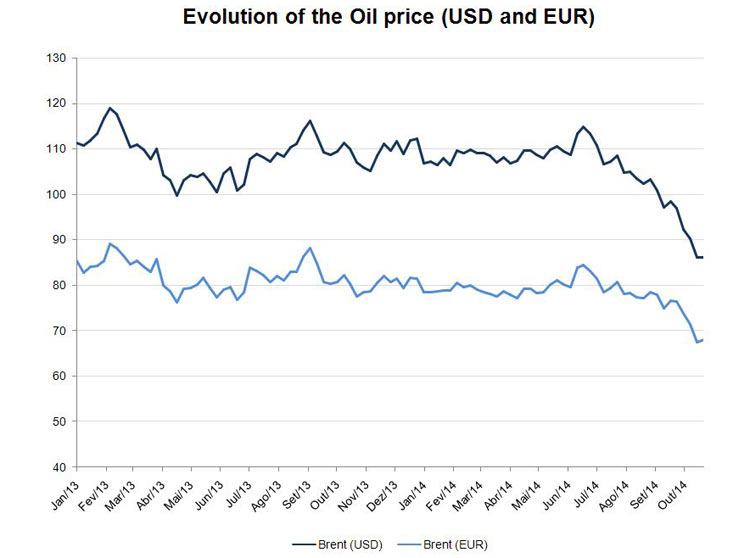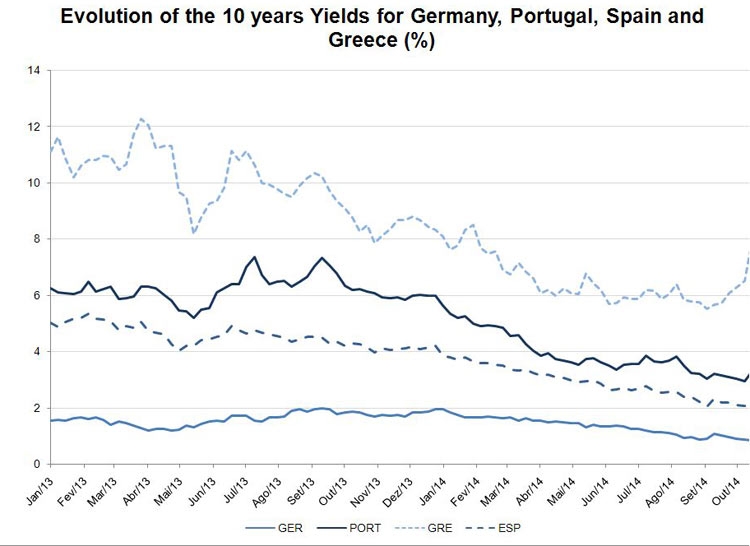Investing
ECONOMIC OUTLOOK

https://www.globalbankingandfinance.com/high-chance-of-inflation-falling-below-one-per-cent-in-2015/
The importance of monetary policy
The most recent data indicate that the environment for the European economies has been mixed over the last months; GDP growth in the European Union and Euro Zone has slowed with year-on-year growth in the second quarter of 2014 standing at 1.2% and 0.7% respectively, down from the previous quarter (1.4% and 1.0%, respectively). There has also been a downward trend in the indicators measuring confidence and economic sentiment in both the Euro Zone and European Union.
It is the decline in the contribution from investment and net external demand that stands out particularly in the Euro Zone’s GDP in 2Q14, though this is partially offset by an improvement in private and public consumption.

Specifically, the ECB’s latest forecasts for GDP in the Euro Zone are for 0.9% growth in 2014, down 0.2% from June’s projections. The forecast for GDP growth in 2015 is 1.6% (0.1% down from June), going up to 1.9% in 2016 (0.1% up from June).
In 2014, the ECB has lowered its reference rates twice, although was less than in previous years. After cutting reference rates by 0.50% to 0.25% in 2013 (taking the rate on the main refinancing operations as reference), at the meeting of June 2014 the European Central Bank made a further cut of 0.10% in intervention rates (at the time to record lows of 0.15% for the main refinancing operations). At the September meeting, the European monetary authorities again lowered their key interest rates, setting the rate for the main refinancing operations at 0.05% (a further cut of 0.1%), a new record low for this reference rate.
The rate on the marginal lending facility, which was at 0.75% in the end of 2013, went down to 0.3%, while the rate for the deposit facility fell from 0.0% at the end of 2013 to -0.2%. This is of the utmost importance insofar as the absorption rate of funds moves into negative territory, which means the ECB wants banks to be more available to grant financing to the economy.
In addition to changes to the intervention rates, the Central Bank confirmed other unconventional monetary policy measures aimed at a better transmission of these changes to the economic activity. Under these measures, the ECB gives banks the option to take funds maturing in September 2018 corresponding to the amount of credit granted to the non-financial private sector, excluding loans to households for the purchase of houses, but which could be increased in the future through operations of a similar nature. The first targeted longer-term refinancing operation (T-LTRO) came in September, and a second is planned for December. The ECB also announced the purchase of some assets that the financial institutions have in their portfolios.
As for the United States, the latest indicators point to a more robust growth in economic activity in the second and third quarters following the unexpected fall in GDP registered in the first three months of the year. The improvement is on the back of a more positive performance of investment and private consumption, reflecting the gradual improvement in the labour market. Thus, after going down 2.1% in the first quarter, the GDP growth rate rose to 4.6% in the second quarter and is expected to be around 3.0% in the third quarter.
As a result of this momentum in the US economy, the FED is continuing the process of reducing the monetary policy incentives for economic growth through a steady cutback in the purchase program of assets on the banks’ balance sheets (initially set at USD 85b/month to USD 15b/month at the mid-September meeting).
However, the Fed Chair-woman has already acknowledged the possibility of bringing forward an increase of intervention rates; meanwhile, at the last meeting she again stated that the key interest rates would remain at quite low levels for a long period of time, even after the asset purchase program is withdrawn.
It is again stressed that monetary policy has been the preferred instrument to stimulate the economy since the start of the financial crisis. With the substantial decline in inflationary pressure, monetary policy has become even more accommodating, not only through the lowering of the reference rates to record lows, often to near zero, but also through the use of unconventional measures that inject liquidity into the financial system.
The US Federal Reserve and the Bank of England have kept their reference rates at low levels over the last year (between 0.0% and 0.25% in the United States and at 0.5% in the United Kingdom). These central banks have also undertaken asset purchase programs designed to influence the long-term interest rates, which in the case of the US are now coming to an end.
The ECB has lowered its intervention rates to historic lows (0.05% since the September 2014 meeting) and in mid-2013 started giving the market a perspective on the future evolution of monetary policy, stating that it will remain accommodative for as long as necessary as a way of anchoring long term interest rates.
It should be noted that over recent months there has been a considerable decline in yields on the public debt securities of most European countries; this reflects the expectation that monetary policy will remain accommodative in a context of low GDP growth rates and low inflation rates, particularly in the Euro Zone where reference has been made to the risk of deflation on several occasions. It is also stressed that the neutrality levels of interest rates are perceived to be lower now than in other economic contexts due to the fact that inflation is anchored at record low levels.
There has also been a marked decrease in the credit spreads associated to the more peripheral Euro Zone countries in relation to the German public debt securities with the same maturity, reflecting a reduction in the respective risk premiums. However, this decline was not linear over the whole year and at times of greater instability in the financial markets, the credit spreads associated to the more peripheral Euro Zone countries widened.
CaixaBI, Best Investment Bank in Portugal

chart credit Bloomberg

evolution of oil prices – chart credit bloomberg

chart credit Bloomberg

-
Finance4 days ago
An Overview of Exchange-Traded Funds (ETFs) and Their Benefits
-
Investing2 days ago
7 Tips to Start Your Retirement Planning
-
Trading3 days ago
FBS Financial Market Analysts Forecast Gold Prices to Rise to $2,800
-
Finance3 days ago
Bandit Network’s Points SDK and Brave Ads Power Astar zkEVM’s Quest Platform “Yoki Origins”







